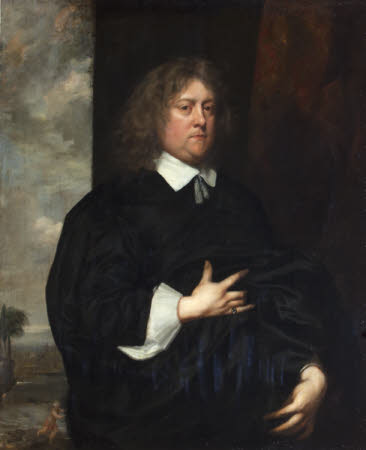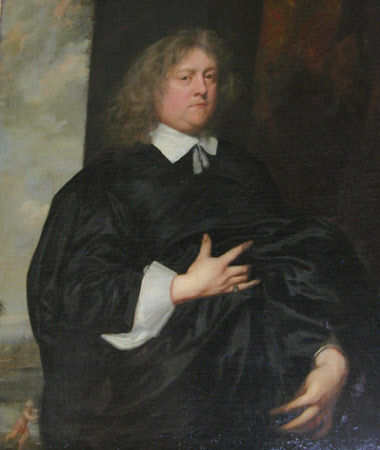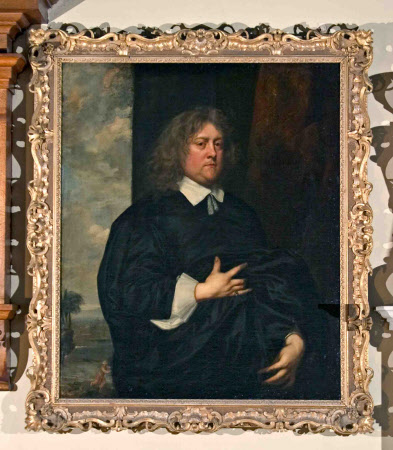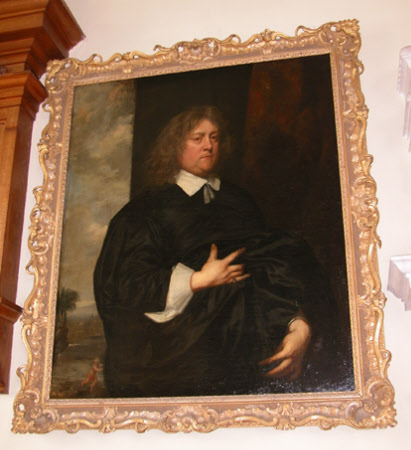Sir William Paston, 1st Bt (1610-1662/3)
Anglo-Dutch School
Category
Art / Oil paintings
Date
circa 1643 - 1644
Materials
Oil on canvas
Measurements
1223 x 1015 mm
Order this imageCollection
Felbrigg, Norfolk
NT 1401197
Caption
William Paston was a remarkable figure, noted for his extensive travels and as most likely being responsible for acquiring the bulk of his family's vast and princely collection, now lost, once held in the family Norfolk country house, Oxnead Hall, at the height of their wealth and fame. After the death of his first wife, Lady Katherine Bertie (d.1636/7), Paston travelled extensively to Italy, Palestine and Egypt. He commissioned Nicholas Stone to construct a monument to deceased wife in St. Michael’s, Oxnead, which was inscribed with a moving and tender inscription from her ‘sad Consort.’ Stone also remodelled Paston’s house, Oxnead Hall between 1631 and 1642. This picture was probably painted in 1642-3, when Paston, due to his Royalist sympathies, was forced into exile in Holland. His clothing and jewellery reflect Dutch fashions of this date. The small scene in the foreground, showing a man fleeing from a crocodile, which is devouring his companion, could have referred to an escape from troubles in the Civil War, or perhaps represented an episode which occurred when Sir William was travelling in Egypt. This portrait is the only known oil which certainly depicts William Paston. A later engraving was made in 1659, but no painted original for this is known.
Summary
Oil painting on canvas, Sir William Paston, 1st Bt (1610-62/3), Anglo-Dutch School, circa 1643/4. A three-quarter-length, portrait of a man, standing, dressed in black with right hand across breast, turned to his right. Behind to the right is a dark curtain and to the left a strip of landscape in which a man is seen escaping from a crocodile which is devouring a second man. The picture has been attributed to Adriaen Hanneman (c. 1603-71) although this attribution is uncertain.
Full description
Sir William Paston, created baronet in 1641, was the son of Sir Edmund Paston of Paston Hall (d.1632) and Katherine Knyvett of Ashwellthorpe (d.1639). Following the death of his first wife, Lady Katherine Bertie, in childbirth around 1636 to 1637, he travelled in Italy, Palestine and Egypt. Sir William’s second wife was Margaret Hewitt, sister of Sir George Hewitt, who married George Strode after his death. Sir William Paston was the first of his branch of the family to settle at Oxnead. He commissioned Nicholas Stone to remodel Oxnead Hall between 1631 and 1642, to make the movingly inscribed tomb of his first wife in St Michael’s Oxnead, and execute the memorial to his mother in 1639 in Paston Church. He was a patron of art and learning (as supported by the still-life ‘The Paston Treasure’ at the Norwich Castle Museum & Art Gallery: 1947.170) and possessed a famous library. As a Royalist, he was forced into exile in the Northern Netherlands from June 1643 – March 1644, and his estates were sequestrated. From then, the estates accumulated debt, which was compounded by the extravagance and unfortunate political allegiances of the remaining family descendants, from Sir Robert, created 1st Earl of Yarmouth, to William, 2nd and last Earl of Yarmouth, on whose death in 1732 Oxmead was broken up, sold, and ultimately demolished. Though buried at Paston, Sir William has no monument. The portrait was likely made during William’s exile from 1643-1644. His clothes reflect Dutch fashions around this time, wearing a small collar with tasselled cords and a single diamond ring. In the background, the water, palm tree and pyramid presumably represent Cario where William stayed during his 1638-39 travels; the crocodiles eating a turbaned man while another red-tunicked man escapes could recall the “stuft” crocodiles William displayed at Oxnead, probably buying them in Egypt. This painting has been attributed to the artist Adriaen Hanneman (c.1603-1671), who was based in The Hague and was often an artist patronised by Royalist exiles. This has been undermined by Karen Hearn’s recent argument that the rendition of Paston’s facial features differed from those used by Hanneman, however. It is probable that this portrait is the one mentioned in the 1683 Oxnead inventory. This is the only known oil painting that conclusively depicts William Paston. A 1659 engraving (National Portrait Gallery: NPG D22890 and NPG D22891) also depicts William Paston but its painted original is untraced.
Provenance
Originally at Oxnead, Norfolk, the family home of the Pastons; almost certainly acquired at the 1732 break-up sale; 1764 inventory (Second Room): Sir William Paston of the Yarmouth Family; thence by descent to Robert Wyndham Ketton-Cremer (1906 - 1969), by whom bequeathed to the National Trust in 1969 Part of the Windham Collection. The hall and contents were bequeathed to the National Trust in 1969 by Robert Wyndham Ketton-Cremer (1906-1969)
Makers and roles
Anglo-Dutch School, publisher possibly Adriaen Hannemann (The Hague c.1601 - The Hague 1671), publisher possibly Henry Stone, known as 'Old Stone' (London 1616 - London 1653), publisher
References
Moore 2018: Andrew Moore, Nathan Flis and Francesca Vanke (eds.), The Paston Treasure: microcosm of the known world, (exh. cat.), New Haven: Yale Center for British Art; Norwich: Norfolk Museums Service; New Haven and London: Yale University Press, 2018., pp. 456-457 (cat.147) Vanke 2018: Francesca Vanke, The Paston Treasure: Riches & Rarities of the Known World (exh. cat.), Norfolk Museum Service, 2018., pp. 44-5



